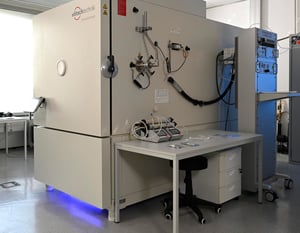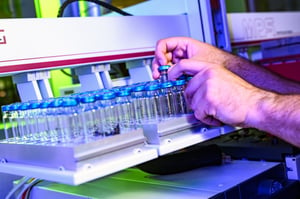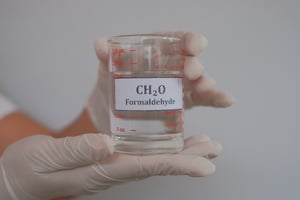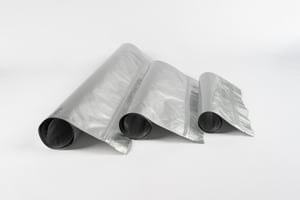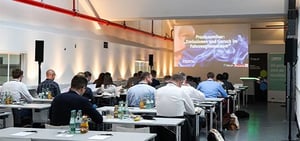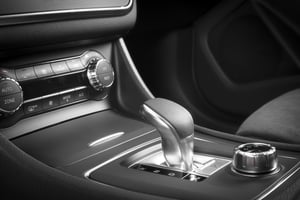
Fogging
Determination of the fogging behavior of materials used in vehicle interiors
FOGGING TEST IN THE
AUTOMOBILE INTERIOR
SAFETY AND RELIABILITY IN ANY CLIMATE
In the modern automotive industry, electrical systems are an essential part of the vehicle - from the control and assistance systems to the entertainment electronics. However, as the complexity of these systems increases, so does the need to ensure their reliability and safety under all conditions. One of the biggest challenges: Temperature-dependent influences on electrical components.
In practice, vehicles are exposed to extreme temperature conditions - from icy cold to blistering heat. The functionality and safety of electrical systems must always be guaranteed under these conditions. This is where temperature-dependent electrical tests come into play. They are not only a basis for meeting legal requirements such as compliance with the VW 80000, LV124 and GS 95024-2 standards, but also make a decisive contribution to ensuring the quality and market acceptance of your products.
As an experienced testing service provider, we are at your side for all challenges. Using proven test methods and modern technologies, we test the reliability, long-term stability and safety of your electrical systems under extreme temperature conditions. From temperature cycles and high and low temperature tests to long-term loads, we offer you a comprehensive range of test methods to identify and eliminate weak points at an early stage.
- Temperature cycles
- High and low temperature tests
- Long-term stress tests
Temperature cycles
Components are subjected to repeated temperature changes to test their reaction to these conditions.
High and low temperature tests
Long-term stress tests

Your requirements: Our expertise
We carry out your test requirements accredited and in accordance with the test specifications to ensure the highest OEM standards:
- BMW GS 95024-3-1
- BMW GS 95024-2
- Mercedes-Benz MBN LV 124
- Volkswagen VW 80000
- Tesla TS-0002476
Fogging test methods
- DIN 75201-A (reflectrometric)
- DIN 75201-B (gravimetric)
- PV 3015 (Volkswagen)
- GMW 3235-A (General Motors Worldwide)
- PSA D45 1727
- and much more.
Are you looking for an exam? Standard? Specifications?
Accredited & certified tests
CONTACT OUR EXPERTS
Description. Lorem ipsum dolor sit amet, consetetur sadipscing elitr, sed diam nonumy eirmod tempor invidunt ut labore et
- Tab Title






Your requirements: Our expertise
Temperature-dependent electrical tests are crucial to guarantee the functionality and safety of vehicle components. The most important aspects are
- Reliability: Vehicles must function perfectly under a wide range of temperature conditions. Temperature changes and extreme temperatures can affect the performance of electrical components.
- Long-term stability: Temperature-dependent tests can identify potential weak points that could have an impact over the lifetime of a vehicle.
- Safety: The safety of vehicle use depends heavily on the functionality of the electrical systems. Defects caused by temperature changes can lead to critical safety problems.
- VW 80000
- MBN50306/MBN10567
- GS 95024-2
VW 80000
This standard describes the requirements for the electrical and electronic safety of vehicle components. It specifies how tests must be carried out under different temperature conditions to ensure that the components function reliably even under extreme conditions.
MBN50306/MBN10567
GS 95024-2
Frequently asked questions about the fogging test
The sample quantities required for a fogging test depend on the standard and the test method used. Here are the general guidelines:
1. standard DIN 75201 (type A and type B)
-
Type A (glass plate method):
A sample quantity of 10 cm² is typically required. The sample is placed on a heated plate in a sealed chamber and the volatiles released condense on a glass plate above. -
Type B (aluminum foil method):
Similar to type A, a sample volume of approximately 10 cm² is used. However, the volatile substances condense on a cooled aluminum foil.
2. standard ISO 6452 (international standard)
- Sample quantity:
Again, a sample size of about 10 cm² is typically required to evaluate the amount of volatiles released at elevated temperature.
3. other specific requirements
Depending on the specific requirements of the customer or OEM standards, sample quantities may vary. It is important to check the respective standards or test requirements carefully.
Method A - Reflectometric method:
- Principle: This method measures the change in reflectivity on a glass plate on which volatile components from the material sample are deposited.
- Procedure: A material sample is heated in a beaker while a glass plate above it is cooled to 21°C. The temperature difference causes the volatile components to condense on the glass plate. The reflectance index of the fogged glass plate is then measured to determine the amount of condensed material.
- Application: This method is particularly suitable for materials for which an exact determination of the optical fog effect is required.
Method B - Gravimetric method:
- Principle: This method measures the weight of condensed volatiles on an aluminum foil.
- Procedure: The material sample is heated in a beaker while an aluminum foil disc is cooled to 21°C. After 16 hours, the amount of condensed material on the foil is weighed.
- Application: This method is ideal for an accurate quantitative determination of the amount of condensed volatiles.
CONTACT US
EMISSIONS & ODOR
Formaldehyd in Fahrzeugen: Herausforderungen für die Automobilindustrie
Read moreStellantis: Freigabe für Emissionsprüfungen erfolgreich (VIAQ)
Read moreVDA 277 vs. VDA 278: Was ist der Unterschied?
Read moreGeruchsunterschiede bei Polypropylen: Die Rolle von Faserverstärkung und Verarbeitungsparametern
Read moreWarum sind die Einheiten der Ergebnisse von Prüfungen der Werkstoffemissionen eigentlich so unterschiedlich?
Read moreGrenzwerte für Formaldehyd und Formaldehydabspaltern in Fahrzeugen
Read moreFREQUENTLY ASKED QUESTIONS ABOUT TEMPERATURE-DEPENDENT ELECTRICAL TESTS
We use various methods as part of the temperature-dependent electrical tests:
- Temperature cycling: components are subjected to repeated temperature changes to test their response to these conditions.
- High and low temperature tests: Components are exposed to extreme temperatures to evaluate their performance and robustness.
- Long-term stress tests: These tests simulate the long-term effects of temperature on the components and help to detect material fatigue or other age-related changes.


